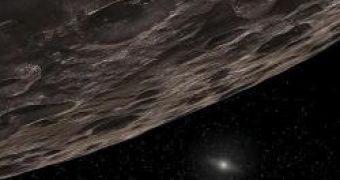The first of these objects, 2003 EL61, was discovered back in 2005 and appears to be a strange shaped body rotating rapidly and chaotically about its axis. The fact that other five objects were found in the same orbit in 2007 suggests that all may have originated from a larger object destroyed during a collision about a billion years ago. Recent observations reveal that the brightness of these objects varies very slightly in relation to Earth, although the fifth object evaded Yale University's detectors.
According to David Rabinowitz, the leader of the study, this suggests that they all have very bright surfaces and may possibly be covered by a layer of ice no more than 100 million years old.
Weird composition
Rabinowitz says that the four smaller companions of 2003 EL61 are somehow puzzling because they should not be able to sustain ice on their surface, while 2003 EL61 is large enough to exert a powerful gravitational pull to maintain an atmosphere that could vaporize and refreeze ice regularly so that it appears to be fresh.
For now, there are no records of such small objects in the solar system having such bright surface, and should in fact be darkened by the action of the solar wind and ultraviolet radiation which breaks down any carbon-based ices, such as methane, leaving behind only other dark, reddish carbon-based compounds.
"Something fishy is going on with this family. We sure have a lot to learn about what happens to ice in the outer solar system," says Caltech researcher Mike Brown, who did not participate in the study conducted at Yale University.
Alternatively, the small objects may contain very little carbon-based compounds, which may explain why they haven't been darkened yet, although the discovery of poor carbon objects in our solar system would definitely be a first. "You'd have to go there with a spacecraft to learn what the surface really is like," says Rabinowitz.

 14 DAY TRIAL //
14 DAY TRIAL //